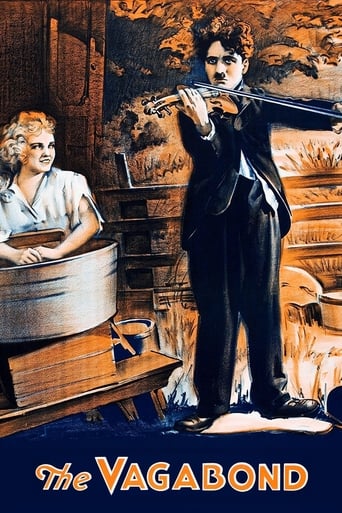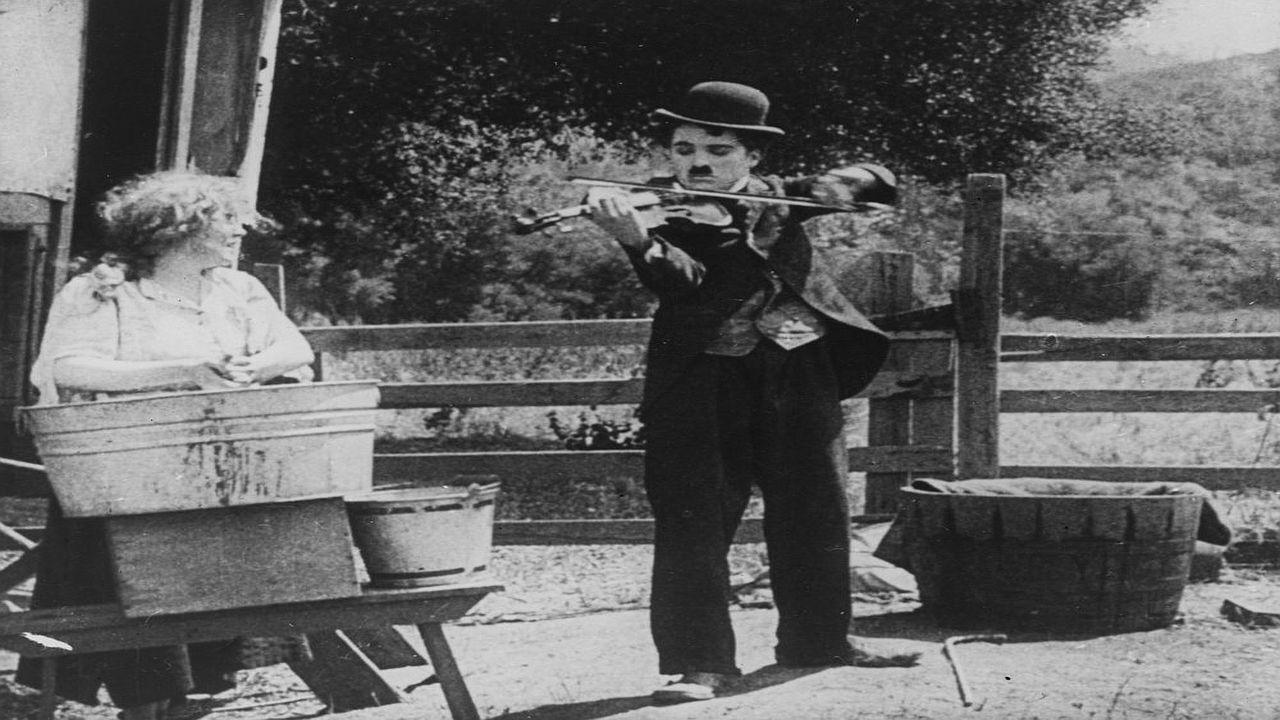lugonian
THE VAGABOND (Mutual Studios, 1916), directed by Charlie Chaplin, stars the legendary Charlie Chaplin in his third comedy short for the studio. With Chaplin's attempt with improving himself with each passing film, rather than the usual twenty minutes of slapstick and chases, he deftly blends humor and sentiment, a standard that would later become associated by his technique in storytelling. Rather than playing a trouble-making tramp, this time Charlie's a violin playing drifter with more human qualities than before.The story opens in great comedy tradition as Charlie enters a bar to play his violin for the patrons. His music is drowned out by a German street band playing outside. As the band leader enters to collect money, he finds Charlie collecting the money instead. A brawl and chase ensues until the crowd loses themselves in the confusion, giving Charlie a chance to sneak away. Charlie next approaches a gypsy drudge where he plays for a gypsy girl (Edna Purviance) washing clothes. A brief cutaway of the plot shows a society matron (Charlotte Mineau), looking at an old photo of a little girl who, believed by its movie audience to have been abducted by gypsies many years ago. Now a young woman, the girl is shown to be an abused slave to the gypsy leader (Eric Campbell). Witnessing one of her brutal whippings that leaves her senseless, Charlie steps in to rescue her, leading to a wild escape down the road in a gypsy caravan. Resting in a secluded spot on a country road, Charlie, having assisted the gypsy girl with her every needs, finds himself in stiff competition when a struggling artist (Lloyd Bacon) enters the scene, inspired by the girl's beauty and uses her as a subject matter to his latest canvas painting, "The Living Shamrock." THE VAGABOND may not be one of Chaplin's most memorable of his comedy shorts for the Mutual Studios, but it represents him here more as a comic-actor rather than a just a slapstick one. Though scripted by Chaplin himself, the story seems to have some influence to Michael Balfe opera, "The Bohemian Girl," which also involves gypsies. While THE VAGABOND could very well have become a straight dramatic story for the possible choices of a Lillian Gish and Robert Harron under D.W. Griffith's direction, instead, it's Chaplin being both Griffith and Harron, and Purviance being Gish. Because its a two-reel comedy, it leaves very little detail for plot and character development. There are moments found in the film where it looks heavily edited. Usually when comedians do drama, or mix comedy with drama, the attempt fails. Fortunately for Chaplin, his method is believable and acceptable as long as he doesn't stray too far from his usual standard of comedy. Of the Chaplin stock players, including Leo White and Frank J. Coleman, Eric Campbell, later known as "Chaplin's Goliath," stands out as the hefty villainous gypsy with the whip, while the funniest performance comes from a character playing an old white-haired gypsy hag. No screen credit is given for his or her work. If played by an actor in drag, all the funnier. And the young artist, played by Lloyd Bacon, the same Bacon who would become a notable movie director himself.Presented on commercial television in the sixties as part of "Charlie Chaplin Theater," and unseen on public broadcasting television since the 1970s, THE VAGABOND was later resurrected a decade later on cable channels and home video. Though various editions have different underscoring, ranging from orchestration to jazz rhythm and blues, Blackhawk Video's edition consisted of reissue prints presented in theaters of the 1930s with the use of sound effects and instrumental scoring to "The Vagabond Lover" and theme scoring used for the independent feature, VANITY FAIR (Allied Pictures, 1932) starring Myrna Loy. When shown on Turner Classic Movies (TCM premiere: December 6, 1999) as part of its "star of the month" tribute to Charlie Chaplin, THE VAGABOND and other Mutual shorts were broadcast in restored clear visuals, new scoring and in accurate silent film speed extending the standard 22 minute short to 34 minutes. Though that's all well and good, poor scoring most of all takes away the enjoyment of the film, leaving the most preferred viewing from Blackhawk (later Republic) Home Video. Next Chaplin short: ONE A.M. (1916) (***)
Petri Pelkonen
Charles Chaplin came up with the Tramp character one hundred years ago, in 1914.In 1916 the world had known him for two years.And that was the year he made this film, The Vagabond.This time he's a saloon violinist, who saves a girl, played by Edna Purviance from a gypsy caravan led by Eric Campbell.Then a painter finds the girl and paints her portrait.But does the painter get the girl? Or is it our beloved little tramp who gets her? Charles Chaplin has come up with a great story, once again.The funniest scene is where he performs for the girl.And he keeps falling into a bucket of water.This all reminds a bit of his latter film Limelight (1952), where he also played the violin.Chaplin was also an amateur violin player.He was really an artist, not just a regular movie maker.
CitizenCaine
Chaplin edited, wrote, directed, and produced this film for Mutual in July of 1916 and it stands the test of time, even more so than many of his earlier much funnier films. The reason probably is that the structure of this film, more than any predating it, resembles (however crudely) the basic plot structure of films today. There is a definitive beginning, middle, and end in this film. The film is well edited and written for its time. Chaplin plays a wandering vagabond who tries to make a living playing his violin in public. The film opens in typical Chaplin fashion with misunderstandings and chases punctuated by sight gags and slapstick. There are those viewers who may wander what the tavern scenario has to do with the rest of the film, and the answer is it sets up Chaplin as a resourceful fellow who gets by with his wits and not his fists. Thus when he meets the sad, browbeaten Edna Purviance, it's clear what Chaplin must do to extricate her from a band of cruel gypsies; he must use some good old-fashioned ingenuity. After rescuing her from the likes of the crude, whip-wielding Eric Campbell in comic fashion, the story settles into its melodramatic mode. The film successfully combines bits of comedy, plot, and pathos-inducing drama in a way that previous Chaplin films had not. The result is a rough draft of the Chaplin formula, which he would later reuse to greater effect and success in his longer features. *** of 4 stars.
drednm
The Vagabond is a funny short film that features Charlie Chaplin as The Tramp. Here he's a wandering violinist who bizarrely finds himself in a gypsy camp, where The Gypsy Drudge--the lovely Edna Purviance--is slaving over a wash tub. He falls in love right away. Several funny episodes here and an oddly happy ending, but there is plenty of Chaplin's stock in trade: masterful comedy, sight gags, and that Victorian sweetness that makes his films so special. Chaplin was a master of creating laughter and tears, and his best films do both. The Kid and City Lights are among the most emotional films you'll ever see. Edna Purviance made more than 20 films with Chaplin and should have been a star in her own right. Eric Campbell, Albert Austin, Charlotte Mineau, and Leo White (as a the gypsy hag) co-star.


 AD
AD



